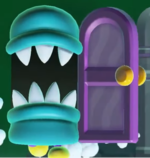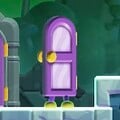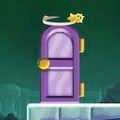Noknok
- This article is about the door enemy from Super Mario Bros. Wonder. For the weapon mistranslated as "NokNok Shell" from Super Mario RPG: Legend of the Seven Stars, see Koopa Shell § Super Mario RPG: Legend of the Seven Stars.
| Noknok | |||
|---|---|---|---|

| |||
| First appearance | Super Mario Bros. Wonder (2023) | ||
| |||
Noknoks[1] are teal enemies with yellow feet and sharp teeth that disguise as Warp Doors. They are introduced in Super Mario Bros. Wonder and appear only in Light-Switch Mansion, KO Arena Fungi Funk and The Final Battle! Bowser's Rage Stage. When the player approaches a disguised Noknok, it reveals itself by screaming and rushing toward the player (if the player has the Invisibility badge equipped, it will simply bounce the player back). It can jump one block and may try to jump to a player on a different platform even if it cannot reach them, only stopping when the player is far away. The enemy can be stunned by being attacked with various power-ups or being stomped. While stunned, players can enter it. If players then enter it, it works as a Warp Door (and remains as a Warp Door) or it is defeated and releases a coin. However, if the player stuns it without interacting with the door, after a while, the enemy will start chasing the player again. Their English name comes from the knock-knock joke, in which the recipient reponds, “Who’s there?”[1]
Some Noknoks can be seen singing and dancing in place during the Wonder Effect in Light-Switch Mansion and The Final Battle! Bowser's Rage Stage.
Gallery[edit]
Additional names[edit]
Internal names[edit]
| Game | File | Name | Meaning
|
|---|---|---|---|
| Super Mario Bros. Wonder | Model/EnemyDoorMoving.bfres.zs | DoorMoving | Moving Door |
| Super Mario Bros. Wonder | Pack/Actor/EnemyChaseDoor.pack.zs | ChaseDoor | Chase Door |
Names in other languages[edit]
| Language | Name | Meaning |
|---|---|---|
| Japanese | トビー[1] Tobī |
Clipping of「 |
| Chinese (traditional) | 牙門[2] Yá Mén |
Teeth Door; also likely a backward spelling of「門牙」(ményá, "incisor") |
| Korean | 무니[3] Muni |
From "門" (mun, Hanja form of "door") and likely the noun-deriving suffix "~이" (-i) |
References[edit]
- ^ a b c マリオたちの行く手を阻む。フラワー王国の個性豊かな敵キャラクターをご紹介。~その1~【ワンダーの世界へ Vol.13】. Nintendo. Retrieved January 26, 2024.
- ^ (February 23, 2024). 阻擋瑪利歐一行人的去路。將為您介紹花花王國充滿個人特色的敵方角色。~第一篇~【前往驚奇的世界 Vol.13】. nintendo.com.hk. Retrieved February 23, 2024.
- ^ (February 8, 2024). 마리오와 친구들을 방해한다. 플라워 왕국에서 만날 수 있는 개성 넘치는 적 캐릭터를 소개. ~제1편~【원더의 세계로 Vol.13】. nintendo.co.kr. Retrieved February 13, 2024.


